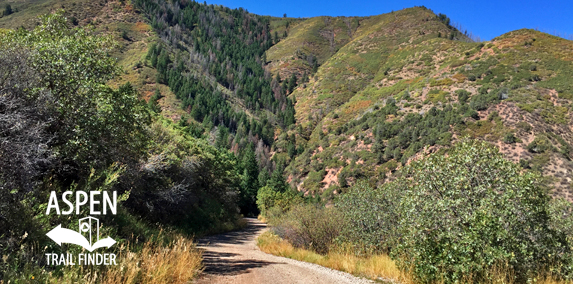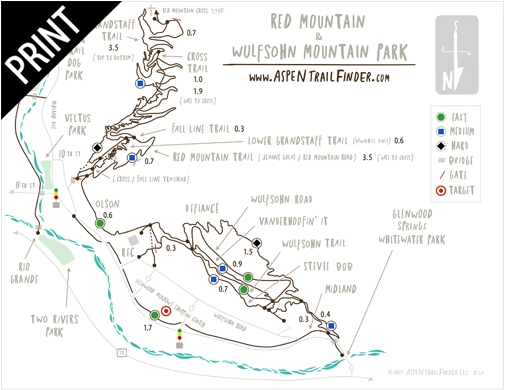Connects: Cross Trail, Fall Line Trail, Grandstaff Trail, Olson Trail, Red Mountain Cross (7,450 ft)

Red Mountain Trail in Glenwood Springs
Glenwood Springs, CO – Medium – 3.5 Miles – Hike, Run, Mountain Bike, Dog Friendly – Dirt
The Red Mountain Trail, also called the Jeanne Golay Trail and Red Mountain Road, is an intermediate/moderate trail you can hike, run, and mountain bike that is dog friendly. The trail/road is 3.5 miles from the gate to the Red Mountain Cross. The road begins with a short paved section to the Red Mountain Water Treatment Facility and then is dirt the rest of the way up Red Mountain. This is a trail in Glenwood Springs, CO.
![]()
![]()
![]()
![]()
Glenwood Springs, CO – Hard – 3.5 Miles – Snowshoe, Fat Bike, Dog Friendly – Snow
Red Mountain Trail, also called the Jeanne Golay Trail and Red Mountain Road, is a difficult trail you can snowshoe and fat bike that is dog friendly. This is a plowed winter road in Glenwood Springs, CO.
News about the Red Mountain Trail can be found at:
Post Independent (November 12, 2017) – Red Mountain trail safety measures taken
In 1991 Jeanne Golay of Glenwood Springs won the annual “Assault on Red Mountain” cycling race on this trail.
In 1992 Jeanne trained on this trail and went on to win 3 gold medals at the National Roadracing Cycling Championships. Later that year, Jeanne finished 6th overall, and 1st on the U.S. Team, in the cycling road race at the 1992 Olympics in Barcelona, Spain.
The citizens of Glenwood Springs proudly dedicate this trail in recognition of Jeanne Golay and her outstanding cycling accomplishments.”
Red Mountain Ski Area
Skiing in Glenwood Springs began in the late 1930’s when J.E. Sayre donated several tracts of land on Red Mountain to the city of Glenwood Springs for the development of a ski area. Volunteers cleared and groomed a small area of the slopes and by the winter of 1938, ski instruction had begun.
In 1940, a group of local businessmen set about to enhance the ski area with the installation of a chairlift. They purchased a tram and wire cable from a mine near Ouray and with the help form Civilian Conservation Corps workers, locals built a ski lift to serve local skiers and visitors alike. Despite closures over the next decade due to problems with ski lift safety and the onset of World War II, Red Mountain Ski Area would operate until 1947.
City Council in 1951 awarded the ski area lease to Joe Juhan. As part of the lease, juhan was required to replace the 15 wooden lift towers with 18 steel towers. He widened and improved the trails and hired former 10th Mtn. Division ski instructor, Ed Jones, to run the ski school. Lift ticket prices were $2.50 per day and a season pass was $32.50.
Lack of sufficient snowfall and competition from newer and more modern ski areas proved to be the demise of Red Mountain Ski Area in the late 1950’s.
Margaret “Cap” Smith made one final attempt to revive skiing on Red Mountain by moving the chairlift higher on the mountain and installing a double chair. Glenwood Mountain Park was open for the 1965-66 season, before closing the book on Red Mountain skiing once and for all.
Why is There A Cross On Red Mountain?
In the summer of 1901, William Grandstaff, an old prospector who had been working gold claims on Red Mountain, had not been seen in town for many weeks. A local youngster was sent up the hill to check on Grandstaff, only to find him dead in his cabin. A committee of townspeople, including the coroner, was dispatched to the cabin. The cause of death was determined to be starvation and Grandstaff was buried on Red Mountain under a tree which stood in the shape of a cross. The tree stood silhouetted for many years at the top of the mountain, but the elements and disease took its toll and eventually, the cross blew to the ground.
In 1951, employees of the Glenwood Springs Electric Department replaced the tree cross with a wooden cross measuring 40 feet by 18 feet. The new cross was electrically lighted using power from the ski tow and placed on city property on a lower ridge of the mountain. This cross stood for forty years.
In 1991, a challenge from the ACLU forced the removal of the cross from city property. A non-profit organization was formed; a metal cross was built and placed on private property at the top of the mountain. In 1998, vandals destroyed the cross so a newer, sturdier cross was erected. William Grandstaff, for whom the original cross was placed, is now a distant memory and the present day cross stands today to light the holiday seasons.
Outdoor enthusiasts familiar with the Moab, Utah area may be interested to know that Negro Bill Canyon, a popular hiking and biking trail there, is named for William Grandstaff. He lived in the canyon prior to coming to the Glenwood Springs area. Upon arriving here, Grandstaff opened a saloon where South Canyon meets the Colorado River, serving the miners of the coal camp at South Canyon. Later, Grandstaff sold the saloon operation and settled on Red Mountain.
When using this trail please keep in mind:
- This trail is considered strenuous.
- Trail is appropriate for hiking, biking, cross country skiing and horseback riding.
- The trail dead ends in 3.5 miles.
- No motorized vehicles are allowed.
- No smoking or fires.
- Take plenty of drinking water.
- Please stay on the designated trail.
- Do not enter private land or utility areas.
- Bikes yield to pedestrians.
- Please pick up after yourself and your pets. Pack out all liter.
- Please respect this land and leave it for others to enjoy.
For more Glenwood Springs history, please visit the Frontier Historical Museum at 10th and Colorado”


























